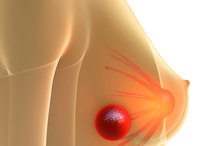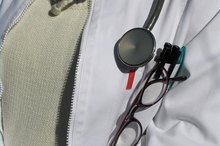What Are the Causes of Thickness in Breast Tissue?
The breasts contain large amounts of glandular tissue, organized into milk-producing lobules and milk-transporting ducts. The lobules and ducts form a complex tree-like structure that connects to the nipple. Normal fluctuations in breast growth can change the palpable consistency of the breasts during menstruation or pregnancy, but a sudden thickening of the breast tissue can indicate the presence of a severe underlying disorder.
Inflammatory Breast Cancer
One possible cause of a noticeable thickening of breast tissue is inflammatory cancer, a rare but aggressive form of cancer. Patients with inflammatory breast cancer develop extensive cancer growth that blocks the lymph vessels in the breast. These vessels normally aid in the circulation of lymph fluid, and blocking these vessels during cancer development leads to a buildup of fluid within the affected breast. The result is an enlarged, red and inflamed breast that can feel sore to the touch. A study published in the journal Radiology in 2002 indicates that patients with inflammatory breast cancer also experience a thickening of the skin on the breast as well as a stiffening of tissue within the breast, leaving the breast feeling abnormally thick. Once diagnosed, patients with inflammatory breast cancer typically receive aggressive cancer therapy, including surgery, chemotherapy, radiation and other drug therapies to treat the cancer.
- One possible cause of a noticeable thickening of breast tissue is inflammatory cancer, a rare but aggressive form of cancer.
- These vessels normally aid in the circulation of lymph fluid, and blocking these vessels during cancer development leads to a buildup of fluid within the affected breast.
Lobular Breast Cancer
Early Warning Signs of Inflammatory Breast Cancer
Learn More
Another possible cause of breast thickening is lobular breast cancer, a form of cancer that first develops from cells within the milk-secreting glandular lobules. Lobular breast cancer accounts for around one in 10 breast cancer cases, according to CancerHelp UK. Unlike some other forms of breast cancer that can present as a palpable lump in the breast, lobular breast cancer feels like a thickening of the breast tissue during cancer development. The thickening is localized in one area of the breast and grows as the cancer develops. Lobular breast cancer is typically diagnosed during a mammogram or clinical examination and can be treated with surgery, radiation and chemotherapy.
- Another possible cause of breast thickening is lobular breast cancer, a form of cancer that first develops from cells within the milk-secreting glandular lobules.
- Unlike some other forms of breast cancer that can present as a palpable lump in the breast, lobular breast cancer feels like a thickening of the breast tissue during cancer development.
Fibrocystic Breasts
A noncancerous cause of a thickening of the breast is a condition called fibrocystic breasts. Under normal conditions, the breasts undergo cycles of growth throughout menstruation, with the breast tissue growing and regressing during specific stages of the menstrual cycle. Patients with fibrocystic breasts experience an exaggerated breast growth, leading to breast pain, formation of scar tissue and an abnormal thickness in the breasts. Imaginis indicates that fibrocystic breasts usually develop due to hormonal disorders, and treatment with hormone-related therapy can treat the disease. Milder cases of fibrocystic breasts may respond to painkiller medications to relieve the pain involved with abnormal breast growth.
- A noncancerous cause of a thickening of the breast is a condition called fibrocystic breasts.
- Imaginis indicates that fibrocystic breasts usually develop due to hormonal disorders, and treatment with hormone-related therapy can treat the disease.
Related Articles
References
- CancerHelp UK: Invasive lobular breast cancer
- Imaginis: Fibrocystic Breasts
- Rousset-Jablonski C, Gompel A.Screening for familial cancer risk: Focus on breast cancer. Maturitas. 2017 Nov;105:69-77. doi: 10.1016/j.maturitas.2017.08.004. Epub 2017 Aug 7.
- National Cancer Institute. Breast Cancer Risk in American Women. Updated October 3, 2019.
- Centers for Disease Control and Prevention. What Are the Symptoms of Breast Cancer? Updated September 11, 2018.
- U.S. Breast Cancer Statistics. BreastCancer.org. Updated February 13, 2019.
- Rousset-Jablonski C, Gompel A. Screening for familial cancer risk: Focus on breast cancer. Maturitas. 2017;105:69-77. doi:10.1016/j.maturitas.2017.08.004
- Liu Y, Nguyen N, Colditz GA. Links between alcohol consumption and breast cancer: a look at the evidence. Womens Health (Lond). 2015;11(1):65-77. doi:10.2217/whe.14.62
- Lam DL, Houssami N, Lee JM. Imaging Surveillance After Primary Breast Cancer Treatment. AJR Am J Roentgenol. 2017;208(3):676-686. doi:10.2214/ajr.16.16300
- Sharma GN, Dave R, Sanadya J, Sharma P, Sharma KK. Various types and management of breast cancer: an overview. J Adv Pharm Technol Res. 2010;1(2):109-126.
- American Cancer Society. Invasive Breast Cancer (IDC/ILC). Updated September 20, 2019.
- Metastatic Breast Cancer Network. Incidence and Incidence Rates. 2019.
- Centers for Disease Control and Prevention. How Is Breast Cancer Treated? Updated September 11, 2018.
- McArthur H.Combining Chemotherapy and Immunotherapy for the Treatment of Triple-Negative Breast Cancer.Oncology (Williston Park). 2019 Apr 15;33(4). pii: 624508.
- Niell BL, Freer PE, Weinfurtner RJ, Arleo EK, Drukteinis JS. Screening for Breast Cancer.Radiol Clin North Am. 2017 Nov;55(6):1145-1162. doi: 10.1016/j.rcl.2017.06.004.
- Rousset-Jablonski C, Gompel A.Screening for familial cancer risk: Focus on breast cancer. Maturitas. 2017 Nov;105:69-77. doi: 10.1016/j.maturitas.2017.08.004. Epub 2017 Aug 7.
Writer Bio
Sylvie Tremblay holds a Master of Science in molecular and cellular biology and has years of experience as a cancer researcher and neuroscientist. Based in Ontario, Canada, Tremblay is an experienced journalist and blogger specializing in nutrition, fitness, lifestyle, health and biotechnology, as well as real estate, agriculture and clean tech.







